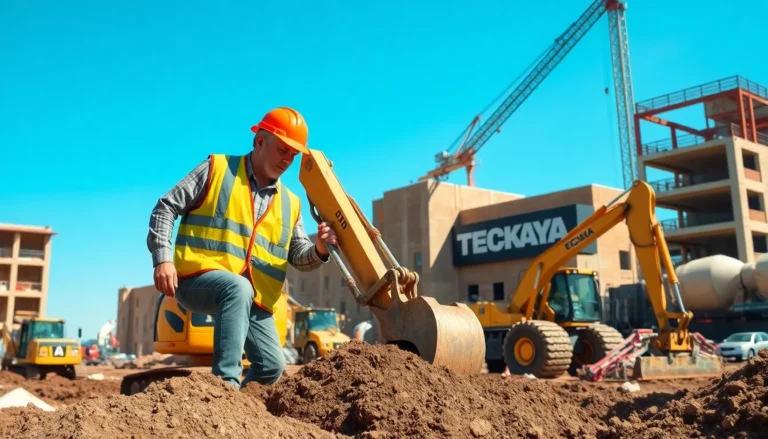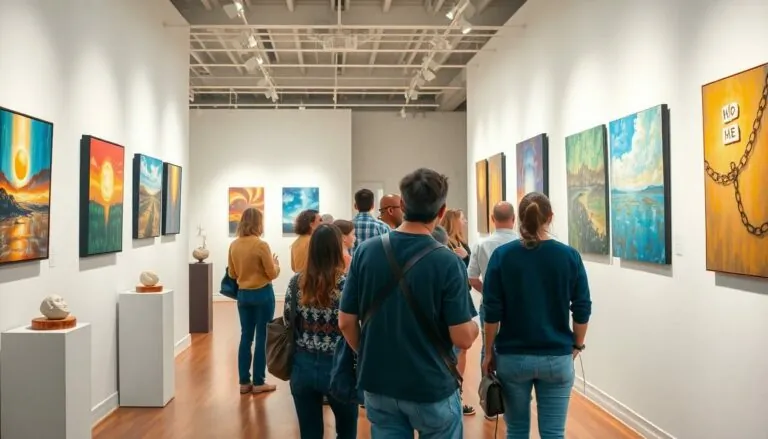Table of Contents
ToggleRelief painting might just be the art world’s best-kept secret. Imagine transforming a flat canvas into a stunning three-dimensional masterpiece that practically begs for a touch. This captivating technique combines the elegance of traditional painting with the tactile allure of sculpture, creating a visual feast that’s hard to resist.
Overview of Relief Painting
Relief painting combines traditional painting and three-dimensional sculpture into a captivating art form. Artists create this technique by layering materials, which results in varied textures and depths on a flat surface. Various mediums, such as paint, plaster, and paper, contribute to the unique visual appeal of these artworks.
Texture plays a crucial role in relief painting, as it engages viewers by inviting tactile interaction. Artists utilize techniques such as carving, molding, or collaging to develop a sense of depth. Intricate designs often emerge from these methods, allowing for a dynamic experience.
Different styles exist within relief painting, including low relief and high relief. Low relief presents subtle elevation from the background, while high relief projects more prominently, providing dramatic shadows and forms. Many famous artists have embraced this technique, enriching their portfolios with standout pieces that demonstrate innovation and creativity.
The history of relief painting spans various cultures and epochs. Ancient civilizations, including the Egyptians and Greeks, utilized this form to embellish temples and monuments. Contemporary artists continue to explore the medium, pushing boundaries and expanding possibilities.
Art enthusiasts appreciate relief painting for its versatility and expressive potential. Galleries often showcase these pieces due to their striking nature, drawing attention from both art critics and the public. With the continued evolution of this form, relief painting retains its significance, captivating new audiences and inspiring future artists.
Historical Background

Relief painting carries a rich history that underscores its importance in the evolution of art. With roots in ancient cultures, this technique reflects a journey through time.
Origins and Evolution
Origins of relief painting trace back to ancient civilizations, including the Egyptians, who used it to depict gods and pharaohs on temple walls. The Greeks further developed the technique, showcasing intricate relief sculptures in their architecture. Throughout the Middle Ages, artisans integrated relief painting into illuminated manuscripts, combining text and imagery effectively. The Renaissance ignited renewed interest as artists like Michelangelo embraced relief techniques, blending sculpture and painting seamlessly. Over time, this art form evolved, incorporating modern materials and methods.
Key Influences
Key influences on relief painting encompass various cultural movements and technological advancements. The introduction of oil paints in the 15th century allowed artists to explore depth and texture more vividly. Additionally, the rise of the Baroque period encouraged dramatic contrasts and emotional intensity in works. The Romantic era spurred a fascination with nature, prompting artists to create organic shapes and forms. In the 20th century, abstract movements expanded the boundaries of relief art, allowing for innovative experimentation. Artists continue to draw inspiration from these rich historical contexts, ensuring relief painting remains a dynamic and evolving medium.
Techniques in Relief Painting
Relief painting encompasses various techniques that enhance its distinctiveness. Artists can choose from a variety of methods to create unique effects on their canvases.
Types of Relief Techniques
Relief techniques fall into two main categories: low relief and high relief. Low relief features subtle protrusions from the background, allowing for minimal depth. In contrast, high relief techniques showcase more dramatic elevations, creating striking three-dimensional forms. Artists often incorporate bas relief and alto relievo within their works, further adding to texture and visual interest. Another approach includes assemblage, where mixed materials create dynamic surfaces. Each technique offers different ways to engage viewers, fostering greater appreciation for the artwork’s dimensionality.
Materials Used
A diverse range of materials engages artists in relief painting. Commonly used items include acrylics, which allow for vibrant colors and quick drying. Plaster serves as a versatile medium, enabling texture variations and structural integrity. Artists often select paper for collage elements, contributing to depth and complexity. Textiles can also play a role, adding unique tactile elements that enhance visual appeal. Furthermore, artists might use found objects as embellishments, enriching the artwork’s narrative and interaction potential. The choice of materials significantly impacts the overall effect and aesthetic of relief paintings.
Notable Relief Painters
Many renowned artists have made significant contributions to relief painting. Henri Matisse is known for his vibrant color application and intricate cut-outs, which enhance the texture of his relief works. Edgar Degas incorporated relief elements into his paintings, often highlighting ballet dancers with layered dimensions.
Relief printing, a form of relief painting, saw significant contribution from Albrecht Dürer. His meticulous attention to line and form created stunning relief prints that influenced generations. Artists such as Claes Oldenburg explored pop art themes through relief by transforming everyday objects into playful sculptures.
Another prominent figure is Anselm Kiefer, whose large-scale works incorporate materials like straw and ash, giving his pieces a raw, tactile quality. Barbara Hepworth stands out for her abstract sculptures, which often combine relief painting techniques with traditional sculpture.
In contemporary art, artists like Julie Mehretu illustrate complex layered compositions that show movement and depth, resulting in engaging visual experiences. Each artist’s approach to relief painting showcases unique stylistic choices and innovations, enriching the medium’s diversity.
Through their work, these notable relief painters continue to influence and inspire. Their distinct techniques and materials contribute to the ongoing evolution and recognition of relief painting as a significant form of artistic expression.
Contemporary Applications of Relief Painting
Contemporary artists utilize relief painting techniques across various mediums and settings. These applications extend beyond canvas and paper, often incorporating environmental elements and large-scale installations. Public spaces frequently showcase relief paintings, transforming cityscapes into vibrant art experiences. Artistic communities increasingly celebrate relief painting in galleries, reinforcing its significance within modern art movements.
In interior design, relief painting enhances decor, adding texture and depth to residential and commercial spaces. Designers embrace its interactive qualities, creating focal points that invite viewer engagement. The flexibility of materials allows artists to experiment, combining traditional with unconventional resources. Acrylics, found objects, and recycled materials emerge as popular choices, promoting sustainability alongside creativity.
Digital platforms now host virtual relief painting exhibitions, expanding audiences and accessibility. Artists leverage technology to create immersive experiences, integrating augmented reality. This innovative approach introduces interactive elements, further enhancing viewer appreciation.
Educational institutions incorporate relief painting into art curricula to foster creativity and hands-on learning. Students explore the interplay of three-dimensionality and traditional techniques, building essential skills for artistic expression. Workshops and community programs also encourage participation, inspiring emerging artists to explore their own styles.
Relief painting continues to evolve, reflecting contemporary themes and societal issues. Many artists address topics such as identity, culture, and environment through their work. This responsive nature demonstrates the relevance of relief painting in addressing today’s challenges while celebrating artistic diversity.
Relief painting stands as a vibrant testament to the fusion of traditional artistry and modern innovation. Its unique ability to engage the senses through texture and depth offers a fresh perspective on visual art. As artists continue to explore and redefine this medium, relief painting remains a dynamic form of expression that resonates with contemporary themes. From historical roots to modern interpretations, it captures the imagination of audiences and inspires future generations. The ongoing evolution of relief painting not only enriches the art world but also invites deeper connections between the artwork and its viewers.







